| “ | The law in an emergency is to kill one's opponent in a single blow, for instance the way research was conducted on soman and sarin during World War II. | ” |
— Asahara
| ||
Shoko Asahara (born Chizuo Matsumoto), was the founder and former leader of Aum Shinrikyo, the Japanese terrorist cult responsible for the infamous Tokyo subway sarin gas attack of 1995.
Background[]
Matsumoto was the fourth son of a poor family of tatami mat makers in Kumamoto province, Japan. As an infant, he lost all sight in his left eye and two thirds in his right eye, due to infantile glaucoma. Because he was unable to follow on the family trade, he was enrolled full-time in a boarding school for the blind, when he was six-years-old, and he never lived with his family again. As the only child with some sight left in the school, Matsumoto found an opportunity to make money in return for guiding other children to a snack shop. This made him popular at the school, although some claimed that he was a bully. Matsumoto soon developed a fantasy about being the absolute leader of a kingdom of intelligent robots, and he told his schoolmates that his dream was to become Prime Minister of Japan one day. In 1973, Matsumoto applied to study politics at Tokyo University, but he was rejected. Afterward, he studied acupuncture and traditional Chinese medicine, both common occupations for the blind in Japan, and he established a Chinese medicine shop outside Tokyo. In 1978, he married and he went on to father either twelve children (officially) or fifteen (the Asahara family's claim).

Asahara with the Dalai Lama.
During this period, he also studied Chinese astrology, eastern and western esotericism, and different religions including Taoism, Buddhism, and Christianity. He let his hair and beard grow and adopted the alias Shoko Asahara. Shoko means "an offering of incense" in Japanese, and Asahara is a typically aristocratic surname, unlike the plebeian-sounding Matsumoto. In 1982, Asahara lost his herbalist license and was briefly imprisoned for selling drugs without a pharmacist license. He opened a yoga school and attempted to create his first cult-like group, but it was a failure. Starting in 1984, Asahara made several pilgrimages to India, where he met Tenzin Gyatso, the 14th Dalai Lama. Asahara claimed that during these travels he achieved Enlightenment, met Shiva, and was trusted by the Dalai Lama with a "special mission" to preach "real Buddhism" in Japan. When asked about this after the subway attack, the Dalai Lama said that he had met "a strange Japanese man," but denied giving any mission to him. Asahara returned permanently to Japan in 1987. He assumed the title sonshi (guru) and claimed that he had mastered meditation to the point of lifting himself in the air with the power of his mind. He advertised this feat with brochures printed by his own publishing house, but it had little repercusion outside of some occult-themed Japanese magazines.
Aum Shinrikyo[]
"Their strategy is to wear you down and take control of your mind. They promise you heaven, but they make you live in hell."
-A detector
Establishment, growth, and first murders[]

Aum Shinrikyo's flag.
In 1987, Asahara legally changed his name and applied to register his new cult Aum Shinrikyo ("Aum Supreme Truth", henceforth "Aum") as a religious association (there is no difference between religions and cults under Japanese law). This status was granted in 1989, exempting Aum's activities from taxation. Keys to this success were Asahara targeting college students and his use of new media including TV, manga, and anime in propaganda. Unlike other Japanese cults, Aum's members were all wealthy and educated, which earned it the nickname of "religion of the elite". Asahara also became obsessed with Nostradamus and the Biblical Armageddon around this time. He created the idea of a "Buddhist Hell" and used it to justify the abduction and torture of defecting members because it was the only way to save them. Later, the same reasoning would be used to justify the murder of people outside the cult; such people were already condemned and a threat to Aum followers. Asahara predicted that Armageddon would start with an American nuclear strike against Japan around 1997 and that only Aum members would survive and repopulate the world. As 1989 progressed, Asahara amassed an enormous wealth from his followers' donations and the sale of relics at exorbitant prices. Outwardly, he continued to live a life as deprived as his followers. His only apparent luxury was a Mercedes-Benz donated by a member. The same year, Aum purchased land near the base of Mount Fuji and built a facility for the production of cyanide gas, mustard gas, sarin and botulinum toxin.
By the end of 1989, controversy had grown about the living conditions in Aum communes and the abduction of defectors. Their relatives hired the services of Tsutsumi Sakamoto, who had gained fame as anti-cult lawyer after successfully leading a lawsuit against the Unification Church. While preparing a similar lawsuit against Aum, Sakamoto personally embarrassed Asahara when he requested a blood sample of the cult leader in order to verify the existence of the "special power" that Asahara claimed was present through his body; afterward, Sakamoto announced that the sample contained nothing special. The last straw was when Sakamoto spoke to TBS about his anti-Aum findings. Aum agents at the station alerted Asahara, who in turn pressed TBS successfully to not air the interview. On November 3, 1989 four Aum members attempted to abduct Sakamoto from a Yokohama train station, but they had to improvise when they found that he had the day off and was at home with his family. At night, four cultists invaded Sakamoto's home and murdered him, his wife and infant son. They took the bodies and disposed of them separatedly. Despite the events directly preceding the disappearances, no link was established between the case and Aum until the perpetrators confessed in the aftermath of the subway attacks.

A march of Aum Shinrikyo members wearing Shoko Asahara masks.
In 1990, Asahara founded his own political party, "Truth", and run for Prime Minister in the general election. It had no political program and its campaign acts consisted exclusively of Aum members chanting Asahara's name. Nevertheless, Asahara had convinced himself that he would be elected to such degree that the news of Truth failing to even enter parliament shocked him immensely. Asahara retreated then to an Okinawan island with 1,000 followers, causing media speculation that he was imitating Jim Jones and staging a mass suicide. Instead, Asahara concluded that his fate was not to be peacefully acclaimed by Japan and then the rest of the world, like Buddha, but that he would be rejected and martyred first, like Jesus. He announced that he was "The Christ" and "The Lamb of God", sent to erradicate sin from the world, and that his declining health was aresult of giving his strength to his followers. Regarding Armageddon, Asahara said that it would still come in the date revealed, but that the war would be started by Aum itself. His sermons acquired an increasingly conspiracist tone, as he accused the Jews, Freemasons, Dutch, the British monarchy and rival Japanese cults of plotting against Aum.
Mass Destruction and Assassination Attempts[]
In 1990, the cult attacked two U.S. bases in Japan and several Tokyo landmarks with botulinum toxin, but they failed to produce victims. In 1991, Aum expanded into post-Soviet Russia and tried to hire Physics Nobel Prize-winner Nikolay Basov to help create an advanced weapons system. The cult built a weapons factory in Ishikawa Prefecture, where they attempted to reverse-engineer AK-74 rifles, but they could not assemble the pieces correctly. They also sent a team to collect an ebola strain in Zaire; another to study Nikola Tesla's works in the Belgrade museum with the aim of creating an earthquake-inducing machine; and forty-eight-thousand acres and mining licenses were purchased in Western Australia with the intention of gathering uranium for an atomic bomb. When the mining equipment turned to be beyond the cult's financed, the land was used to test anthrax attacks. A new round of bacteriological attacks happened in 1993, targeting Crown Prince Naruhito's wedding and Tokyo landmarks, but they were also unsuccessful. Afterward, the cult turned its efforts to the production of VX, phosgene, hydrogen cyanide (a.k.a. Zyklon B) and sarin. The cult intended or attempted unsuccessfully to assasinate TV producer Dave Spector and manga artist Yoshinori Kobayashi for satyrizing them; Daisaku Ikeda, the honorary president of rival cult Soka Gakkai; and Taro Takimoto, a lawyer who had taken over Sakamoto's planned lawsuit. Asahara also considered acquiring a nuclear weapon or materials to build one from North Korea and Russian mobsters, then launching a wave of nuclear or chemical attacks in the United States. Washington, D.C. and Disneyland were named as targets.
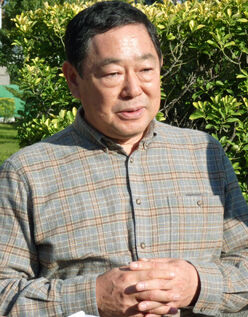
Yoshiyuki Kouno, the man wrongly accused of perpetrating the Matsumoto sarin gas attack.
On June 17, 1994, Aum released a sarin cloud in Matsumoto, Nagano Prefecture, near the homes of judges overseeing a real-state dispute that was predicted to go against the cult. They were unharmed, but seven others were killed, and up to 500 were injured. A woman, Sumiko Kouno, was left comatose. Police zeroed on Kouno's husband, Yoshiyuki, after a large volume of pesticides was found in his home. This suspicion was leaked to the media, which presented Kouno as the undisputed author of the attack and dubbed him "the Poison Gas Man". Although sarin was identified as the cause of the attack one week later, the harassment of Kouno (which included hate mail and death threats) continued because the second largest newspaper, Asahi Shimbun, falsely claimed that nerve agents could be synthesized from pesticides. On July 9, dozens suffered similar but non-fatal symptoms in Kamikuishiki, a village north of Tokyo. The investigation determined that this gas was not sarin but a byproduct of its fabrication. Locals blamed nearby Aum facilities and claimed to have seen members wearing gas masks around the time of the incident. The attack was also preceded by several lawsuits against Aum over land disputes, building permits and general harassment by cult members. In September, seven gas incidents were reported in Nara Prefecture, all non-fatal. In September 20, the cult attempted to murder journalist and Aum critic Shoko Egawa with phosgene gas. Between November 1994 and February 1995 they also tried to murder several people with VX, including Noboru Mizuno, who had sheltered Aum defectors; Hiroyuki Nagaoka, an anti-Aum activist; and Ryuho Okawa, leader of the cult Happy Science. An officinist who was believed to be a police informant by Aum, Takahito Hamaguchi, became the first person ever to be killed in a VX attack. Also in February, the cult abducted 68-year-old Kiyoshi Kariya and subjected him to a fatal interrogation during an attempt to learn the whereabouts of his sister, who had defected.
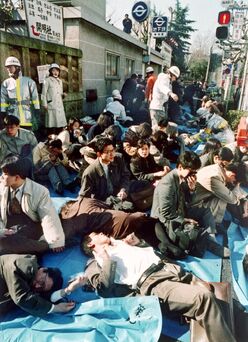
Afflicted passangers and emergency personnel outside the subway, in the immediate aftermath of the attacks.
Although the investigation was slow and overly cautious, Police eventually found a relation between Aum's legal troubles in Matsumoto and Kamikuishi, the attacks, and a gas leak near Aum facilities in Tokyo, in July 1993. On January 5, 1995 (one day after the attack against Nagaoka), Aum tried to mislead Police by filing a lawsuit against a chemical company they accused of releasing sarin in their Kamikuishi facility. In February, a chemical weapons expert concluded that the attacks were test runs for a larger attack. On March 5, several passengers in the Keihin Kyuko-Yokohama line suffered from vomit and eye irritation and had to be hospitalized; on March 15, three suitcases altered to disperse botullinum toxin were found near a ticket machine in Tokyo's Kasumigaseki Station, next to the National Assembly and close to the Imperial Palace. Police requested thousands of gas masks and other protection systems to the Army, and began drills for a wave of raids against Aum facilities. On March 19, Police seized Aum's facility in Osaka after a family complained that a relative was being held inside against its will. The same day, Aum bombed its own base in Tokyo's Aoyama District and attempted to kill Hiromi Shimada, a college professor and Aum sympathizer, in an attempt to make Police action look like part of a general, violent crackdown of the cult. On March 20, ten Aum members launched a concerted sarin gas attack on the Tokyo subway (one of the world's busiest) in the morning rush hour. Though the incident caused the hospitalization of 5,510 people and was considered the largest disruption in Japan since the nuclear bombings of Hiroshima and Nagasaki, only thirteen people died. Asahara was reported to be disappointed with this result. Over the following week, Police raided several Aum facilities, uncovering large caches of explosives, weapons and laboratories for the manufacture of drugs, chemical and biological agents. 150 members were arrested for various offenses, but Asahara and other leaders went into hiding and released statements denying authorship of the attacks and claiming that any material found was to produce fertilizer. On May 30, the National Police Agency's chief survived an assassination attempt near his house in Tokyo. The case remains unsolved but Aum involvement is suspected. The cult tried to attack the subway again in May and July. These attacks used hydrogene cyanide instead of sarin, and were aborted before they could produce victims.
Arrest, Incarceration, and Aftermath[]
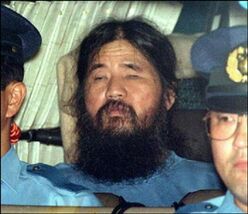
Asahara at the time of his arrest.
Asahara, who didn't have a private residence, was found hiding in a small room of Aum's Kamikuishiki complex on May 15 and arrested. He was accompanied by a collection of small bottles containing pubic hair, each of which was labeled with the name of a female follower he had slept with as part of her initiation. The next day, a bomb was mailed to the Governor of Tokyo, Yukio Aoshima, and his secretary was injured in the explosion. Asahara refused to speak while in custody and has remained silent ever since, not even talking to his lawyers. They claimed he was both unfit to stand trial and innocent of the attacks, which they argued were carried by other Aum officials without his knowledge. However, he was ruled sane and found guilty of 13 of 17 charges, including the Sakamoto family murders. Asahara was sentenced to death by hanging on February 27, 2004, but in June 2012, his execution was postponed until all Aum fugitive leaders were located and arrested. Twelve other Aum members were also sentenced to death.
The Japanese Diet debated laws that would illegalize Aum, but eventually ruled against passing them. Instead, new measures to monitor groups considered a threat to society, including Aum, were adopted. In February 2000, Aum refunded itself as "Aleph"; Asahara and all violent methods were denounced, the most controversial doctrines inspired by Vajrayana Buddhism and Christianity were removed, and the group apologized to the subway victims and established a compensation fund for them. On March 8, 2007 Aleph split between its Japanese and Russian branches. The latter, led by Funichiro Joyu was renamed Hikari no Wa ("The Circle of Light"). However, in 2016 the Russian government declared Aum a terrorist organization and banned all of its versions. The two branches exist today in Japan. In 2017, Police raided five Aleph offices during an investigation on its recruiting practices.
On July 6, 2018 Asahara and six of his followers were executed by hanging in Tokyo. The remaining six followed on July 26.
Modus Operandi[]
"The subway poisoning seems to represent an aggressive, outward-reaching insanity, as if Koresh had somehow become melded with the Tylenol Killer."
-TIME Magazine
Aum's internal function[]
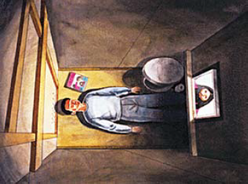
Depiction of a holding cell used to imprison defectors.
Asahara's recruiters targeted academically brilliant, but socially isolated college students who looked for meaning in their lives. The initiated cut relations with friends and family donated all belongings to the cult, and were subjected to rituals that erased their individuality and made them subservient to Asahara. They dressed in white yoga outfits, wore masks modeled after Asahara's face, and put on helmets with cables attached that were claimed to armonize their thoughts with Asahara. Sex and marriage were banned to all members except Asahara, who had relations with female recruits during their initiations, and he kept samples of their pubic hair afterward. Followers showed their devotion by kissing Asahara's big toe, drinking his bath water and making soup from his hair. Those who tried to leave the cult (and eventually also their relatives and cult critics) were abducted and taken back to Aum complexes, where they were imprisoned, injected with LSD; subjected to light, food and sleep deprivation; and beaten with rods and electroshocks. The children were separated from their parents and received no education but the teachings of Asahara. In some cases, the victims were murdered by lethal injection or strangulation.
The Sakamoto familicide[]
The Sakamoto family home was invaded through an unlocked door at 3 AM. Tsutsumi was struck with a hammer, and Satoko was beaten. The cultists injected their son with potassium chloride, killing him, and covered his face with a cloth. Afterward, they injected the parents with the same substance, killing Satoko but failing to kill Tsutsumi, who was subsequently strangled. As a counterforensic measure, all three bodies were taken from the house in bedsheets and driven back to Aum's headquarters. The sheets were burned, the tools used in the murders destroyed, and the adult victims had their teeth smashed to difficult recognition. The bodies were encased in metal drums and buried in rural areas of three different prefectures: Tsutsumi in Niigata, Satoko in Toyama, and Tatsuhiko in Nagano.
Bacteriological and early chemical attacks[]
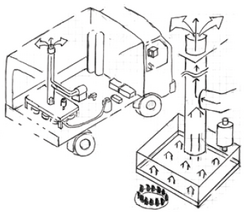
The dispersion system employed in the first sarin gas attack, as drawn by Tomomasa Nakagawa.
These attacks employed modified trucks, sometimes one only and others up to three acting in a concerted manner. The bacteria were cultivated in large, vertical stainless drums on the box, which were fitted with an entering tube to make air enter when the truck moved, and an exiting tube that combined with those of other drums and led to a disperser on the back of the truck. The ineffectiveness of this system led to bacteriological attacks being abandoned. The chemical attacks employed one truck only. The gas was contained in a single box in the cargo area, with a heat source at the base and a chimney that dispersed the gas through the top of the truck. At the Matsumoto attack, the cult employed a larger refrigerated truck, with three separate heating sources and chimneys, and lateral fans to increase dispersal. All systems were designed to not require more than two people in each truck, including the driver.
Kiyoshi Kariya's murder[]
Kariya was taken to Aum headquarters, injected with pentothal and interrogated until he died of unknown causes. His body was destroyed in a microwave and his ashes disposed in a lake.
The Tokyo subway attacks[]
The five attackers carried two packages of volatile sarin totalling 0.9 L each (except Yasuo Hayashi, who carried a third defective package as a loyalty test), a sharpened umbrella, and a surgical mask of the type commonly worn by Japanese people during cold and flu seasons. They bought newspapers and magazines of the day to hide the packages and boarded trains in different lines. At prearranged stations, the packages were dropped and punctured several times with the umbrellas. The attackers left immediately and boarded different cars, each with a getaway driver and a vial of antidote.
Notable Aum Shinrikyo members[]
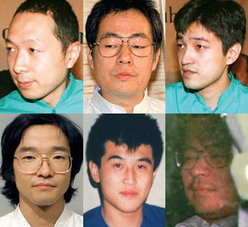
In reading order: Murai, Hayakawa, Joyu, Endo, Tsuchiya and Nakagawa.
The Sakamoto family murderers
- Hideo Murai (December 5, 1958 - April 23, 1995)
- Physics graduate and chief scientist
- Manufactured VX and chlorine gas
- Stabbed to death by a Yakuza hitman while in the presence of police and about a hundred journalists
- Satoro Hashimoto (c.1967 - 2018)
- Martial arts master
- Also drove a vehicle spraying sarin in Matsumoto in 1994
- Sentenced to death and executed on July 26, 2018
- Tomomasa Nakagawa (1962 - 2018)
- Former medical resident and Asahara's personal doctor
- Sentenced to death in 2011 and executed on July 6, 2018
- Renounced his Aum beliefs in 2017, apologized to the families of the victims, and called Asahara a criminal
- Shared his discoveries on sarin production with US toxicologist Anthony Tu while he was in prison
- Kazuaki Okazaki (1961 - 2018)
- Construction worker
- Joined the cult in 1986 and defected in 1990
- Blackmailed Asahara while he was in hiding
- Turned himself in in 1995, confessed his part in the Sakamoto and Taguchi murders and pled guilty to all charges
- Sentenced to death in 1998 and executed on July 26, 2018
The Tokyo Subway Attackers
- Ikuo Hayashi (b. January 23, 1947)
- Former heart doctor
- Tortured suspected defectors with sodium pentothal and electric shocks
- Sentenced to life in prison instead of death because of his cooperation with police
- Ken'ichi Hirose (1957 - 2018)
- Physics graduate
- Studied superconductivity until he dropped out to join the cult; his former supervisor claimed this was a great loss for the field
- Involved in Aum's light weapons development program
- Was poisoned during the attack and had to be given the antidote
- Sentenced to death and executed on July 26, 2018
- Toru Toyoda (1968 - 2018)
- Physics graduate
- Joined the cult in 1992
- Engaged in weapons research and development
- Pleaded guilty and said he didn't deserve to have lived
- Sentenced to death and executed on July 26, 2018
- Masato Yokoyama (1964 - 2018)
- Joined the cult in 1989
- Physics graduate and former electronics company employee
- Involved in the light weapons development program
- Sentenced to death and executed on July 26, 2018
- Yasuo Hayashi (1958 - 2018)
- Artificial Intelligence graduate
- Joined the cult in 1988
- Oldest member of Aum's Ministry of Science and Technology
- Given an extra package of sarin because he was suspected of being a spy by Asahara
- Sentenced to death and executed on July 26, 2018
- Tomomitsu Niimi (1964 - 2018)
- Home Affairs minister
- Joined Aum in 1986
- President of two front chemical companies of Aum
- Poisoned while driving a faulty sarin truck in 1993, but was administered the antidote
- Attempted to kill Shoko Egawa and Hiroyuki Nagaoka
- Getaway driver of Ikuo Hayashi at the subway attacks
- Sentenced to death in 2010 and executed on July 6, 2018
- Accepted his death sentence and reiterated his faith in Asahara
- Koichi Kitamura
- Getaway driver of Ken'ichi Hirose at the subway attack
- Sentenced to life imprisonment
- Katsuya Takahashi
- Getaway driver of Toru Toyoda at the subway attack
- Arrested in 2012 and sentenced to life imprisonment in 2015
- Kiyotaka Tonozaki
- Getaway driver of Masato Yokoyama at the subway attack
- High school graduate and member of Aum's Ministry of Construction
- Sentenced to life imprisonment
- Shigeo Sugimoto
- Getaway driver of Yasuo Hayashi
- Sentenced to life imprisonment
Other members
- Kiyohide Hayakawa (1949 - 2018)
- Chief arms dealer, procurer and reputed right hand man of Asahara
- Leftist militant since the 1960s
- Avid reader of Occult-themed literature
- Agriculture engineer, renounced his job after reading Asahara's book in 1986
- Became one of the first Aum monks when the priesthood was established
- Arrested in 1995, sentenced to death and executed on July 6, 2018
- Fumihiro Joyu (b. December 17, 1962)
- Media liaison and "teen girl idol" in the early 1990s
- Former National Space Development Agency employee
- Succeeded Asahara as leader of Aum and changed its name to Aleph in 2000
- Seiichi Endo (1961 - 2018)
- Veterinarian and former AIDS researcher
- Health and Welfare minister
- Leader of the biological weapons program
- Harvested botulinum toxin and anthrax
- Sentenced to death in 2002 and executed on July 6, 2018
- Masami Tsumiya (1965 - 2018)
- Chemistry student
- Introverted and mentally ill
- Manufactured sarin and several other chemical compounds, supposedly to defend Aum from an outside attack
- Sentenced to death in 2004 and executed on July 6, 2018
- Makoto Hirata (b. 1966)
- Driver at Kiyoshi Kariya's abduction
- Also found guilty of the two March 19, 1995 bombings
- Surrendered himself to justice in 2011 and was sentenced to nine years in prison
- Naoko Kikuchi (b. 1972)
- Involved in the production of sarin used in the Tokyo attack
- Sprayed three men with VX in late 1994, including Takahito Hamaguchi
- Arrested in June, 2012
- Yoshihiro Inoue (c. 1970 - 2018)
- Intelligence chief
- Joined Aum when he was 16 and was considered Asahara's closest disciple
- Renounced the cult and convertd to Buddhism after his arrest in 1995
- Sentenced to death in 2009 and executed in July 6, 2018.
Profile[]
Asahara was subjected to a psychiatric evaluation after his arrest, which was never released. Dr. Kris Mohandie's profile of Asahara for the Investigation Discovery's program Most Evil states as follows:
- "To inflict violence on such a massive scale, one must have a delusional view of the world and his place in it. The leader of a group that carries this sort of violence must clearly be a master of manipulation and must be bankrupt of remorse. Mercifully, it is rare for an individual to possess both traits. Asahara's visions appear to be the sign of a delusional disorder. The fact that he is a guru yoga instructor and therefore already in a position of authority, makes his delusions potentially more harmful to others. As Asahara's disciples continue to worship him as a god, his ego is inflated and his delusions are intensified, ultimately making him even more dangerous. Self-centered and psychopathic, Asahara revealed his general contempt for humanity by scheming to commit murders that would spark an apocalyptic war. There is an extremely high level of evil in Asahara; his delusions however, qualify as a form of mental illness."
Mohandie gave Asahara a score of 16/22 in Stone's scale, corresponding to a psychopath capable of extreme violence.
Known Victims[]
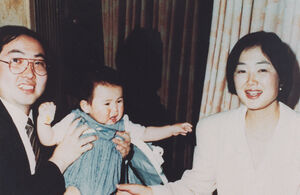
The Sakamoto family.
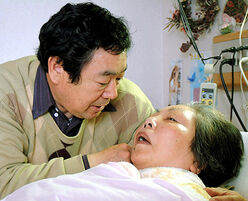
Yoshiyuki Kouno and his wife, Sumiko.
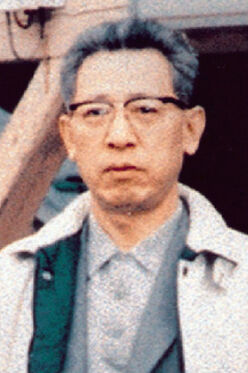
Kiyoshi Kariya.
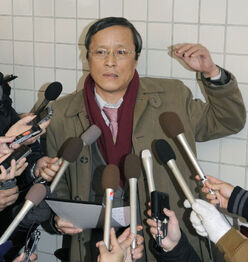
Attempted victim Taro Takimoto.
- February 1989: Shuji Taguchi, 21 (a defector; strangled by Niimi)
- November 5, 1989, Yokohama: The Sakamoto family (all injected with potassium chloride)
- Tsutsumi Sakamoto, 33 (strangled when he took too long to die)
- Satoko Sakamoto, 29
- Tatsuhiko Sakamoto, 2
- April 1990: Several botulinum toxin attacks (all failed to produce victims)
- Two US naval bases
- Narita airport
- The National Diet
- The Imperial Palace
- The headquarters of an unnamed rival cult
- 1993:
- June-August, Tokyo: (all failed)
- The attack on Crown Prince Naruhito's wedding (using botulinum toxin)
- Two attacks near Aum's HQ (using anthrax)
- Two attacks on the National Diet (using anthrax)
- Two attacks on the Imperial Palace (using anthrax)
- Two attacks on the Tokyo Tower (using anthrax)
- November 18 - December 20, 1993: Daisaku Ikeda, 63 (attempted to kill twice with sarin)
- Unspecified date: Yoshinori Kobayashi, 40 (attempted)
- Unspecified date: A gas leak near Koto District
- June-August, Tokyo: (all failed)
- 1994:
- January: Kotaro Ochida (lynched and strangled for trying to leave the cult)
- May 9: Taro Takimoto (attempted to kill with sarin; attempted again with VX in Mid-September, and with botulinum toxin on November 4)
- June 27: The Matsumoto sarin gas attack
- Sumiko Kouno, 46 (wife of Yoshiyuki Kouno; left in a coma, died in 2008)
- Yutaka Kobayashi, 23 (killed)
- Mii Yasumoto, 29 (killed)
- Five unnamed people killed
- 200-500 unnamed people injured
- Several unnamed judges (intended; unharmed)
- July 9: The Kamikuishiki gas attack
- Several unnamed people (all non-fatally poisoned)
- September 20: Shoko Egawa, 36 (attempted to kill with phosgene gas)
- Unspecified dates in September: 7 gas attacks in Nara Prefecture
- November 26: An unnamed man (poisoned with VX; survived)
- December 2, Osaka: Noboru Mizuno, 83 (poisoned with VX; survived)
- December 12: Takahito Hamaguchi, 28 (poisoned with VX, died 10 days later)
- 1995:
- January 4: Hiroyuki Nagaoka (attempted to kill with VX)
- Late January to February:
- Ryuho Okawa, 38 (attempted to kill with VX)
- Kiyoshi Kariya, 68 (abducted, drugged and tortured until he died of unknown causes; incinerated postmortem, his ashes were thrown in a lake)
- March 5: The gas attack in the Keihin Kuko - Yokohama line
- March 15: The first attack in Kasumigaseki Station (using botulinum toxin; failed)
- March 19:
- Hiromi Shimada (attempted to kill with a bomb; was unharmed)
- An Aum facility in Tokyo's Aoyama District (attacked with a Molotov cocktail; a false flag action)
- March 20: The Tokyo subway attack (using sarin)
- Chiyoda Line:
- Kazumata Tatahashi (Kasumigaseki station subchief; killed)
- An unnamed station attendant (killed)
- Marunouchi Line (Ogikubo-bound)
- Ken'ichi Hirose (the attacker, accidentally poisoned himself; survived)
- An unnamed passenger (killed)
- 358 other unnamed people (injured)
- Marunouchi Line (Ikebukuro-bound)
- Over 200 unnamed people (injured only)
- Hibiya Line (Tōbu Dōbutsu Kōen-bound)
- An unnamed passenger (killed)
- 532 other unnamed people (injured)
- Hibiya Line (Naka-Meguro-bound)
- Eight unnamed people (killed)
- 275 other unnamed people (injured)
- One other unnamed person (killed)
- 4145 other unnamed people (injured)
- Chiyoda Line:
- March 30: NPA Chief Takaji Kunimatsu (possibly; shot four times; survived)
- May 3-5: The second attack on Shinjuku subway station (using hydrogen cyanide; twice failed)
- May 16:
- Tokyo Governor Yukio Aoshima, 63 (intended to kill with a bomb; was unharmed)
- Masaaki Utsumi (Aoshima's secretary; lost his left hand's fingers)
- July 4: The third attack on the Tokyo Subway (using hydrogen cyanide; failed)
On Criminal Minds[]
- Season One
- "The Tribe" - Asahara and his followers appeared (using stock footage) when the BAU commented that the episode's unsubs had surrendered their individual personalities to a group and adopted a shared mentality. In particular, they appeared when Morgan mentioned that the group might share a religious faith.
- Season Four
- "Amplification" - While not directly mentioned or referenced in this episode, Asahara appears to have been an inspiration for the episode's unsub, Chad Brown - Both were terrorists, poisoners, and mass murders (Asahara by proxy) who attacked a subway station with a Bacteriol agent.
- Season Eleven
- "The Witness" - Asahara was referenced and apparently served as a major inspiration for the episode. Besides the attack, Asahara and Aum were referenced directly (though not by name) because the BAU briefly considered them suspects in the new case. It was mentioned that Asahara was blind, wheelchair-bound and in death row in Japan; and that Aum has split into two rival cults that have presence in southern California but have also denounced Asahara and the Tokyo attack. Though neither Asahara nor Aum were responsible for the attack in the episode, it was revealed that the real perpetrator was a homegrown terrorist with an anti-government agenda, like Asahara, and that the bus attack was a prelude to a larger sarin gas attack against government personnel. This second attack failed partly because of conflict between the mastermind of the attack and the agent tasked to carry it out, loosely mirroring the attacks that followed the main Tokyo subway attack. He also appears to have been a basis for the episode's unsub, Mitchell Crossford - Both were homegrown terrorists, mass murderers, and poisoners (by proxy in Asahara's case) who had anti-government agendas, attacked numerous public places (including a public transit) with sarin gas, their attacks had body counts in the double-digits and survivors ranging in the thousands, and their last attack failed somewhat due to conflict between them and an agent tasked with carrying it out.
Sources[]
- Wikipedia:
- Japan's Prophet of Poison: Shoko Asahara
- Psychological aspects of the Aum Shinrikyo affair.
- Political Paranoia: The Psychopolitics of Hatred (1997)
- I have lived in the monster (1998) by Robert Ressler and Tom Shachtman
- The Changing Face of Terrorism: How Real is the Threat from Biological, Chemical and Nuclear Weapons? (2010)
- Investigation Discovery's Most Evil's episode on Shoko Asahara and other cult leaders
- Japan Times article about Hirata's sentence
- Asahi Shimbun article about Kouno's death
- Aum Shinrikyo: Insights into how terrorists develop biological and chemical weapons
- Aum killer’s death sentence finalized (2005)
- Japan rejects clemency appeal of last Aum Shinrikyo cult member (2011)
- Death row AUM cult members moved from Tokyo before execution (2018)
- Profiles of executed members, by The Japan Times
- New York Times article on the 2018 executions
